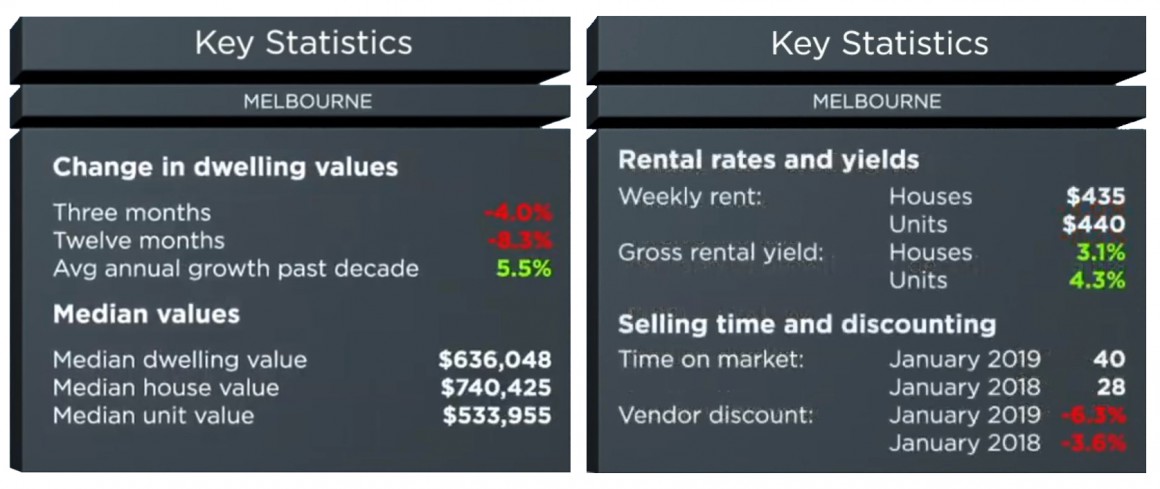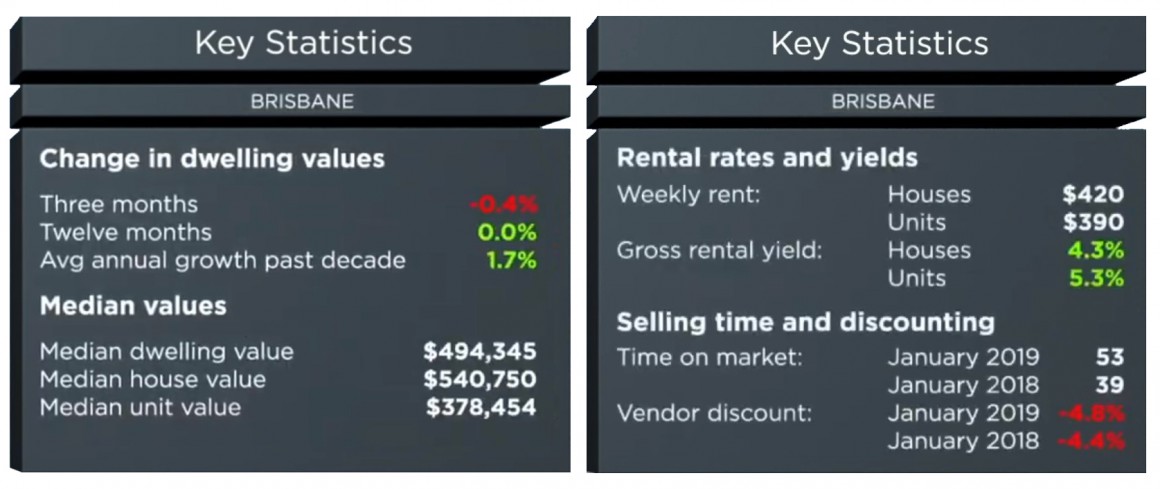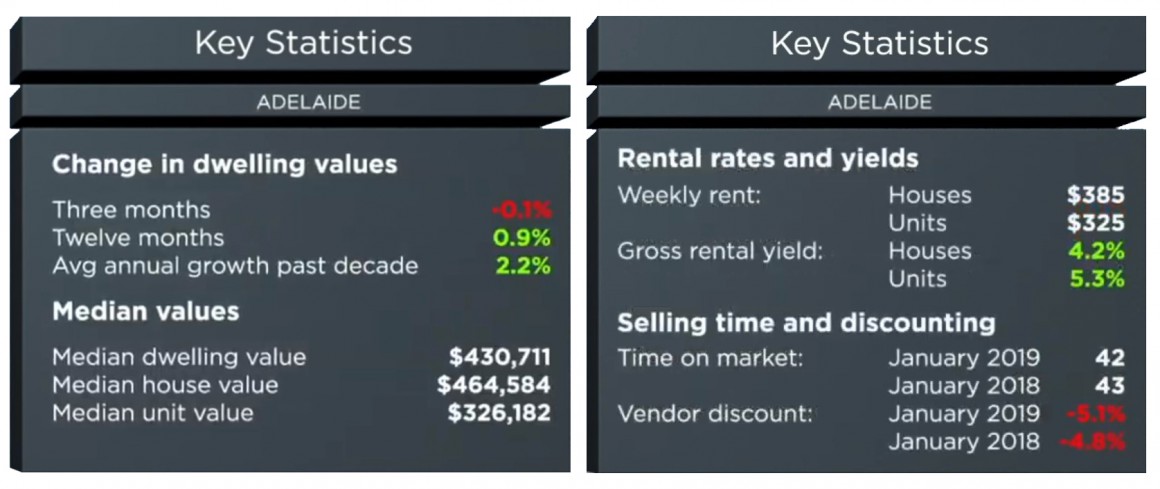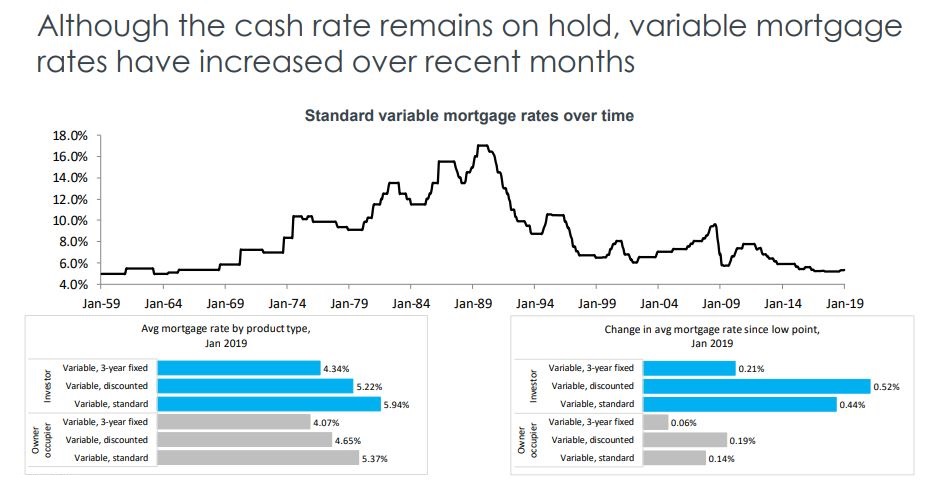2019 is already turning out to be BOOM year.
A boom year for scary headlines and fright that is!
Firstly, there are all those problems overseas including an increased downside risk for the economies of the USA and China.
At the same time there is confusion about the effects of Brexit and the effects of international trade wars.
Then back home our economy is also facing headwinds which is creating increasing concerns of an impending recession (which, by the way, I don’t think this is likely.) 
And there is talk about the RBA lowering interest rates to rescue our housing markets and the economy (which, by the way, I do think is likely.)
Having said that while lowering interest rates may help demand, it really won’t be sufficient to boost our real estate markets because it’s not really the cost of money that is making it hard for home buyers and investors at the moment – interest rates are at historic lows.
It’s the banks’ tougher lending criteria including their careful scrutiny of borrower’s personal spending habits and their stricter servicing criteria that is creating the bottleneck.
At the same time general consumer confidence will need to rise to bring more people back into the property market and this is unlikely to occur until the result of the upcoming Federal election is clear.
Yet despite all this I can’t see a property “crash” in sight – we are experiencing what I’m calling a “soft landing.”
You see…there are no forced sales with desperate vendors having to give their homes away at any price.
The current downturn is quite different from previous ones which have typically been triggered by a change in monetary policy (rising interest rates) or because of economic shocks such as the Global Financial Crisis or a local recession.
This time round we’re in the middle of an orchestrated slowdown due to significantly tighter credit conditions brought on by our regulators who wanted to avoid the type of market crash we could have experienced had the Sydney and Melbourne property markets kept growing at the unsustainable rate they were.
However, to some degree our regulators have caused exactly what they were trying to avoid – a significant market slowdown – by limiting the availability of credit too much.
Of course there were other factors that contributed to the current downturn in Melbourne and Sydney.
These included:
- Property values grew strongly at a time of low wages growth and this eventually tested affordability levels
- A building boom, particularly of high-rise apartments, increased supply which eventually outpaced demand
- Demand from foreign investors decreased, in part because we pulled the welcome mat from under their feet with extra taxes and levies and also because he Chinese Government wanted to stem capital outflow.
But before you get too gloomy about all this…
Remember that our property markets have always been cyclical and some of the best profits are made by investors at this stage of the cycle.
That’s because these downturns are only temporary, while the long term increase in value of well located capital city properties is permanent.
And looking at the long term fundamentals I see a long list of positives for our property markets as the Australian economy, employment and population growth are sound.
So now let’s look at the latest statistics and charts provided by Corelogic to see what’s happening to the property markets around Australia.
And it looks like the New Year has kicked off in a similar way that last year ended, with housing values broadly falling across most regions of Australia.


Higher value housing markets continue to lead the market downturn.
As always happens at the stage of the cycle the highest value quarter of the market has led the national downturn.
This is particularly evident in Melbourne, where values across the top quartile are down 12.4% over the past twelve months and 13.8% lower since peaking.
Sydney’s top quartile of the market is showing a similar trend with values down 10.8% over the past twelve months and 14.6% lower since peaking.

Sydney Housing Market
The Sydney property market peaked in mid 2017 after dwelling values surged almost 80% since the beginning of the last cycle in 2012.
Sydney real estate values have been falling consistently since then, with values now around levels they were at two and a half years ago declining 12.3% since their peak. 
Interestingly there has been a larger decline in the value of houses in Sydney (- 10.9% over the last 12 months) than in the Sydney apartments (-6.9% in the last year).
First home buyers are active in Sydney creating stronger markets over the lower quarter of the market – especially apartments.
The Sydney housing market is likely to remain weak for the first half of this year and then pick up after the Federal election.
Obviously some segments of the Sydney property market are likely to fall considerably more than that average this year (we’re looking at you off the plan properties), while some segments of the market are holding their own.
Investors are abandoning the off the plan apartment sectors and many of those who purchased off the plan a few years ago are now having trouble settling with valuations coming in on completion at well below contract price at a time when banks are more reluctant to lend on these properties. 
But in the background strong economic growth and jobs creation is leading to population growth and ongoing demand for property in Sydney.
At the same time international interest from tourists and migrants continues.
Sydney is currently offering investors an opportunity to buy established apartments in the eastern suburbs, lower north shore and inner west in a “buyer’s market” with little further downside and the prospect of the market moving forward again in late 2019.
If you’d like to know a bit more about how to find these investment gems give the Metropole Sydney team a call on 1300 METROPOLE or click here and leave your details.

Melbourne Housing Market
The Melbourne property market peaked in November 2017 four months after Sydney and values have now fallen back to where they were in January 2017.
Property values are down 8.3 % over the last year but the Melbourne property market is very fragmented. 
The most expensive quarter of Melbourne properties recorded a 12.4% fall in value over the last year while the least expensive quarter of the market is down by less than 1% over the same time supported by first home buyers taking advantage of stamp duty concessions.
Overall property values will be underpinned by a robust economy, jobs growth Australia’s strongest population growth and the influx of 35% of all overseas migrants.
Remember…Melbourne rates as one of the 10 fastest growing large cities in the developed world, with its population likely to increase by around 10% in the next 4 years.
If you’d like to know a bit more about how to find investment grade properties in Melbourne please give the Metropole Melbourne team a call on 1300 METROPOLE or click here and leave your details.

Brisbane Housing Market
Brisbane property is finally going to have its turn in the sun with reasonable growth likely for well located, free standing houses and townhouses in small complexes.
While the overall figures for the Brisbane housing market remained flat over the last year the markets are very fragmented.
Corelogic report that house prices grew 0.1% over the last 12 months while apartment prices fell 0.5%, but digging deeper into the stats freestanding Brisbane houses with 5-7 km of the CBD or in good school catchment zones have grown in value strongly. 
However, it will be some time yet before the oversupplied apartment market starts to pick up.
Brisbane’s economy is being underpinned by major projects like Queen’s Wharf, HS Wharf, TradeCoast, Cross River Rail, the second airport runway and the Adani Coal Mine, but jobs growth from these won’t really kick off for a few more years.
In the meantime, a healthy level of affordability at a time of increased interstate migration from Sydney and Melbourne and the return of local and interstate investors seeking strong rental yields plus capital growth should help make 2019 a good year for Brisbane property.
Our Metropole Brisbane team has noticed a significant increase in local consumer confidence with many more homebuyers and investors showing interest in property.
At the same time we are getting more enquiries from interstate investors there we have for many, many years.
If you’d like to know a bit more about how to find investment grade properties in Brisbane please give the Metropole Brisbane team a call on 1300 METROPOLE or click here and leave your details.

Adelaide Housing Market
Adelaide house values grew 0.9% last year and the Adelaide property market is likely to chug along nicely again this year, much like it has the last few years.
New jobs are being created by many new projects like the $2.4 billion Royal Adelaide Hospital and the Port Adelaide defence contract for manufacture and maintenance of military boats leading to improving migration rates.
However Adelaide’s property markets are very fragmented with challenges in some of the northern suburbs.
While Adelaide remains the most affordable capital city for houses at present and while things look good in the short term, over the next few decades the bulk of Australia’s long-term jobs growth, economic growth and population growth will occur in our 4 big capital cities meaning there are better locations for long term wealth creation that Adelaide.

Perth Housing Market
The Perth property market has been on a downward trajectory and are now down 16.5% since peaking in June 2014.
About 12 months ago there were signs that the Perth market was bottoming out, but in the second half of last year and in January 2019 prices continued to fall. 
The only good news on the horizon for investors is that Perth rentals are starting to improve after falling more than 20% since peaking in 2013.
While the Perth market may level out in the next year, it’s much too early for a countercyclical investment in the west – I can’t see prices rising significantly for a number of years.
Due to the reluctant demand from investors and the significant oversupply of new apartments there is little to no prospect of capital growth or rental growth in the Perth apartment market for many years.
Like the other states, Western Australia’s population trend has a significant impact on the overall performance of its property market.
To get people back into the State more jobs will need to be created.

Hobart Housing Market
While Hobart has been the best performing property market in the last three years, it is likely that 2019 will be the year that things change and the Hobart market loses its momentum.
Over the last few years too many investors chased the Hobart “hot spot” at a time when there was a lack of employment drivers, insufficient population growth and not enough infrastructure spending.
Remember home buyers create a property market (they make up 70% of buyers) and investors create property booms – which is what’s happened in Hobart.
And Hobart is too small a market to be a long term “investment grade” proposition.

Darwin Housing Market 
The Darwin property market peaked in August 2010 is still suffering from the effects of the end of our mining boom today with a very soft employment market, lack of migration and infrastructure spending.
The small size of the Darwin market makes it more susceptible to local events and Darwin typically has a higher and more variable vacancy rate, a product of a large transient working population.
Darwin does not have significant growth drivers on the horizon and would be best avoided by investors

Canberra Housing Market
Canberra’s property market is a “quiet achiever” with dwelling values having grown 4.3% over the last year with house price growth (+5.1%) much stronger than the apartment market (+1.5%)
Economic growth in the A.C.T is projected to begin to slow in the 2019 financial year, yet remain above the national average.
Population growth is expected to remain strong, which will support underlying demand for dwellings.
With public sector employment accounting for more than 40% of jobs in the Australian Capital Territory, if history repeats itself the uncertain political climate leading up to the federal election later this year will reduce local consumer confidence and dampen housing demand a little.
But, as always, this will correct itself after the election and Canberra’s property market is likely to continue to perform well in the medium term.

The Rental Market
The rental markets around Australia continue to slow, with national rents 0.4% higher over the month and 0.4% higher over the past year. 
Corelogic report that this was the slowest annual rate of growth on record since they started collecting data in 2005.
This is unusual as rents usually rise at a time of softening property markets when fewer Australians buy property and more remain as tenants.
However the oversupply of properties is satisfying rental demand.
On the other hand rental yields have continued to lift from their record lows as rental growth outpaces value growth, however yields generally remain well below the long term average in most cities.

Signs of our Softer Markets
Corelogic’s estimate of settled property sales is down 13.2% nationally over the last 12 months, Darwin and Canberra were the only cities in which sales volumes rose over the year.
At Metropole we have noticed increased enquiries from both home buyers and investors keen to get into the property market in 2019 and there have been many more people attending open homes and showing genuine interest.
While these signs are encouraging, this has not yet translated into increased sales.
As you can see from the following charts the number of days it typically takes to sell a property and vendor discounting rates are trending higher while auction clearance rates track lower.

It looks like vendors have got the message that the market has softened and there are now fewer discretionary sellers putting their properties up for sale meaning there are fewer new listings being added to the market.
However the total number of properties advertised for sale is much higher, particularly in Sydney and Melbourne, due to a slower rate of sales.


Lower auction clearance rates are an indication of the weaker demand for property.
While the year has started off a little stronger interest, and auction clearance rates last weekend were stronger than at the end of 2018, currently there are still fewer genuine bidders turning up to those properties selling at auction and the result is fewer properties are selling at auction.

Supply and demand
While Australia’s population continues to grow quite rapidly, the rate of growth has slowed as both the rate of net overseas migration and the rate of natural increase fell.
Population growth in both Sydney and Melbourne is tapering slightly with a slight drop in net overseas migration, as well as an increase in interstate migration from Melbourne and Sydney to South East Queensland.
Having said this, Melbourne is still experiencing interstate migration from South Australia and West Australia.
Of course slower population growth has a negative implication for housing demand.

On the supply side, with the property boom long behind us property developers have lost their appetite to take on new projects and dwelling approvals are falling sharply with house approvals -11.1% lower year-on-year and unit approvals down -38.0% year-on-year.

Finance
With the Haynes Royal Commission report now delivered, the good news is that there were no recommendation for further tightening of the Bank’s lending criteria which would have obviously worsened the current property downturn.
Official interest rates remain at 1.5%, but the RBA has changed its tune accepting that the next movement could even be drop interest rates.
In fact many credible economists believe an interest rate cut is likely later this year because of our weaker economy.
However some banks are still delivering out of cycle interest rate rises citing the increasing cost of funds.

Housing finance data shows the slowdown in investment lending and while owner occupier lending has slowed it remains relatively healthy, rising 6.8% over the 2018 calendar year.
At the same time investor credit has increased at an historically slow rate of 1.1% due to the credit squeeze caused by tighter lending criteria.

Our 2 largest property markets have born the brunt of weakening investor demand.

In general investors and many first home buyers are looking at the same type of properties in the same price brackets.
So with falling investor demand, first home buyer finance commitments have climbed higher since the middle of 2017 as they take advantage of various incentives.

THE BOTTOM LINE…
We’re clearly in for another interesting year in property, one with moderate price growth in some locations and virtually no growth in others and falling prices in yet others.
Australia’s property markets are very fragmented, driven by local factors including jobs growth, population growth, consumer confidence and supply and demand. 
This makes it an opportune time for both home buyers and investors to buy property at a time when they’ll face less competition.
Remember that our property markets are behaving as they always do and some of the best profits are made by investors at this stage of the cycle.
That’s because these downturns are only temporary, while the long term increase in value of well located capital city properties is permanent.
However correct asset selection will be more important now than ever, so only buy in areas where there are multiple long term growth drivers such as employment growth, population growth or major infrastructure changes.
Similarly suburbs undergoing gentrification are likely to outperform.
WHAT CAN YOU DO TO STAY AHEAD?
As signs point to softer growth conditions for Australian property over the coming months, independent professional advice and careful consideration will be as important as ever in navigating Australia’s varied market conditions.
If you’re looking for independent advice, no one can help you quite like the independent property investment strategists at Metropole.
Remember the multi award winning team of property investment strategists at Metropole have no properties to sell, so their advice is unbiased.
Whether you are a beginner or a seasoned property investor, we would love to help you formulate an investment strategy or do a review of your existing portfolio, and help you take your property investment to the next level.
Please click here to organise a time for a chat. Or call us on 1300 20 30 30.
Source of graphs and data: CoreLogic












No comments:
Post a Comment